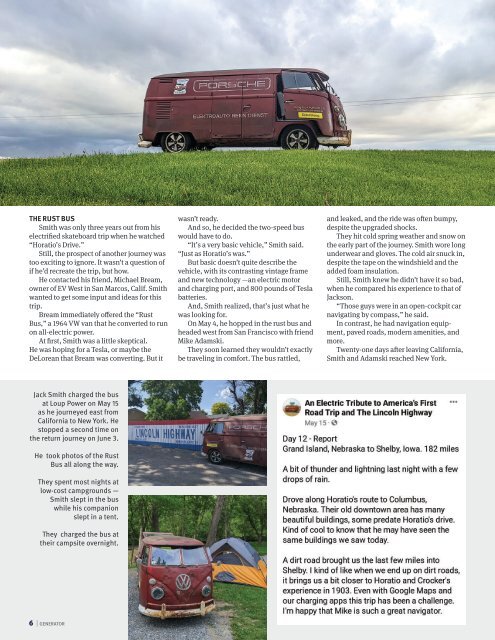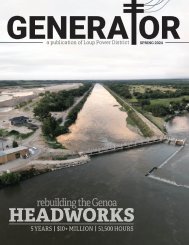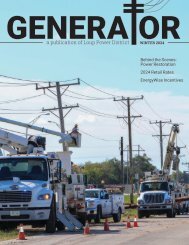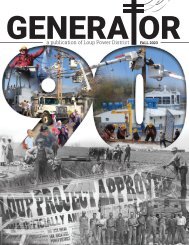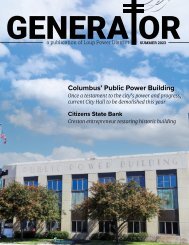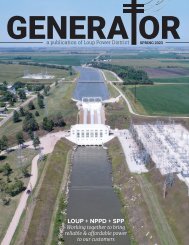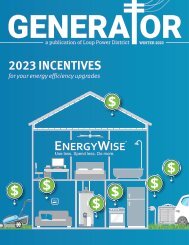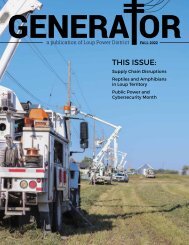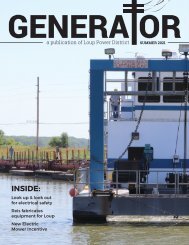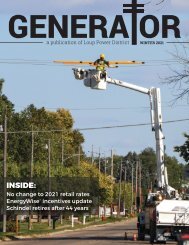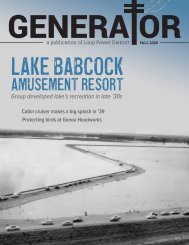Generator—Summer 2022
In this edition: A Californian retraces Horatio's Drive and the Lincoln Highway in a 1964 Volkswagon Bus converted to run on electricity; an underwater inspection at the Monroe Powerhouse; summer safety tips; and more.
In this edition: A Californian retraces Horatio's Drive and the Lincoln Highway in a 1964 Volkswagon Bus converted to run on electricity; an underwater inspection at the Monroe Powerhouse; summer safety tips; and more.
Create successful ePaper yourself
Turn your PDF publications into a flip-book with our unique Google optimized e-Paper software.
LARRY & THE LINCOLN HIGHWAY<br />
Smith successfully completed Horatio’s<br />
drive east. After a short break, it was time to<br />
head home.<br />
And this time, he was going to follow the<br />
Lincoln Highway — the first transcontinental<br />
road in the United States.<br />
The highway was dedicated in 1913 and<br />
ran from Times Square in New York City to<br />
Lincoln Park in San Francisco. Cities and<br />
towns along the 3,389-mile route prospered<br />
as travelers took to “America’s Main Street.”<br />
The Lincoln Highway was gradually<br />
replaced with numbered designations in<br />
1926. Much of the route is now U.S. Highway<br />
30.<br />
Smith took a short break in New York<br />
and it was time for Mike Adamski to head<br />
home. But he got a new companion for the<br />
second leg of the journey — his friend Larry<br />
Newland.<br />
Newland was one of the first people<br />
Smith met when his family moved to Morro<br />
Bay, Calif.<br />
Like Smith, he is lured by adventure.<br />
He once walked a portion of the Donner<br />
Party route from Reno, Nev., over the Sierra<br />
Nevada mountains into Placerville, Calif.<br />
He had planned to be a part of Smith’s<br />
1976 skateboard trip, but backed out because<br />
he started a rock band.<br />
“Almost 50 years later, here we are on a<br />
cross-country trip,” Smith said.<br />
There is no fundraising cause for this trip.<br />
“It’s just a fun adventure,” he said.<br />
But their costs were minimal. At night,<br />
the pair typically stayed at campgrounds.<br />
Smith slept in the bus on top of the batteries,<br />
while Newland pitched a tent. They plugged<br />
in the bus to charge overnight so they were<br />
ready to hit the road by morning.<br />
Along the way, they met a lot of interesting<br />
people who were intrigued by the<br />
bus and wandered over to take a look —<br />
young and old, police officers, construction<br />
workers in downtown Manhattan.<br />
“It’s an attention magnet,” Jack said.<br />
“First they come up and they’re excited by<br />
the bus because they think it’s cool,” he said.<br />
“It makes them smile.”<br />
When they found out it was electric, they<br />
wanted to see the motor and batteries.<br />
The pair was always willing to show off<br />
the bus, talk about their adventures, and<br />
answer questions.<br />
The most popular question?<br />
“How far can you go on a charge?”<br />
THE RUST BUS<br />
Smith was only three years out from his<br />
electrified skateboard trip when he watched<br />
“Horatio’s Drive.”<br />
Still, the prospect of another journey was<br />
too exciting to ignore. It wasn’t a question of<br />
if he’d recreate the trip, but how.<br />
He contacted his friend, Michael Bream,<br />
owner of EV West in San Marcos, Calif. Smith<br />
wanted to get some input and ideas for this<br />
trip.<br />
Bream immediately offered the “Rust<br />
Bus,” a 1964 VW van that he converted to run<br />
on all-electric power.<br />
At first, Smith was a little skeptical.<br />
He was hoping for a Tesla, or maybe the<br />
DeLorean that Bream was converting. But it<br />
Jack Smith charged the bus<br />
at Loup Power on May 15<br />
as he journeyed east from<br />
California to New York. He<br />
stopped a second time on<br />
the return journey on June 3.<br />
He took photos of the Rust<br />
Bus all along the way.<br />
They spent most nights at<br />
low-cost campgrounds —<br />
Smith slept in the bus<br />
while his companion<br />
slept in a tent.<br />
They charged the bus at<br />
their campsite overnight.<br />
wasn’t ready.<br />
And so, he decided the two-speed bus<br />
would have to do.<br />
“It’s a very basic vehicle,” Smith said.<br />
“Just as Horatio’s was.”<br />
But basic doesn’t quite describe the<br />
vehicle, with its contrasting vintage frame<br />
and new technology —an electric motor<br />
and charging port, and 800 pounds of Tesla<br />
batteries.<br />
And, Smith realized, that’s just what he<br />
was looking for.<br />
On May 4, he hopped in the rust bus and<br />
headed west from San Francisco with friend<br />
Mike Adamski.<br />
They soon learned they wouldn’t exactly<br />
be traveling in comfort. The bus rattled,<br />
and leaked, and the ride was often bumpy,<br />
despite the upgraded shocks.<br />
They hit cold spring weather and snow on<br />
the early part of the journey. Smith wore long<br />
underwear and gloves. The cold air snuck in,<br />
despite the tape on the windshield and the<br />
added foam insulation.<br />
Still, Smith knew he didn’t have it so bad,<br />
when he compared his experience to that of<br />
Jackson.<br />
“Those guys were in an open-cockpit car<br />
navigating by compass,” he said.<br />
In contrast, he had navigation equipment,<br />
paved roads, modern amenities, and<br />
more.<br />
Twenty-one days after leaving California,<br />
Smith and Adamski reached New York.<br />
1916 Lincoln Highway Official Road Guide<br />
FROM A TRICKLE TO A FIRE HYDRANT<br />
Newland kept a log every day of the<br />
journey. The top speed of the Rust Bus is<br />
about 95 miles per hour. Generally, they took<br />
a leisurely pace of about 40–55 miles an hour<br />
since they traveled mostly on state highways<br />
and some back roads.<br />
He loved that part of the trip.<br />
After all, he asked, are you really seeing<br />
our country if you’re barreling down the<br />
interstate at 70 miles an hour?<br />
They averaged about 20 miles per 10<br />
percent of battery power on their trip west.<br />
That equates to about 200 miles per<br />
charge in ideal conditions. That range<br />
decreased in hilly terrain or windy<br />
conditions.<br />
But a 200-mile range is just fine with<br />
Newland. After a few hours in the car, he<br />
needed a break to stretch his legs and get a<br />
cup of coffee or bite to eat.<br />
He believes that is a business model for<br />
the future. Imagine charging your car while<br />
having coffee with a friend or getting your<br />
groceries. Convenience stores could add<br />
amenities for EV owners who need to take a<br />
break from the road and charge up.<br />
“This trip has helped shape my idea<br />
about the viability of electric vehicles,”<br />
Newland said.<br />
He’s guessing that in 5 to 10 years, most<br />
people will have an electric car that they use<br />
for trips to the store, to school, to work. But<br />
they will also have a gas-powered pickup<br />
or car for their family vacations or home<br />
improvement projects.<br />
He knows not everyone sees electric<br />
vehicles in such a positive light, but he also<br />
witnessed people change their mind after<br />
learning about the bus and their trip.<br />
Some were shocked at the bus’ instant<br />
torque. Others learned that the most they<br />
paid for a charge was about seven bucks— a<br />
lot cheaper than a full tank of gas.<br />
But Newland said the range question is<br />
the main drawback for many.<br />
“When the first question ceases to be,<br />
‘how far can you go on a charge,’ electric<br />
cars are going to take off,” he said.<br />
For true success, he thinks potential EV<br />
owners will need to see charging stations at<br />
every gas station. They will need a range of<br />
300 miles. Five hundred would be better.<br />
And finally, the cost of a new EV needs to<br />
come down.<br />
He knows that will happen. New technology<br />
is always expensive, but eventually<br />
the price comes down.<br />
Smith is also convinced that electric cars<br />
will eventually take off — just like other<br />
inventions throughout history that found<br />
plenty of skeptics. Heck, Horatio may never<br />
have made history if he didn’t bet against<br />
those naysayers more than 100 years ago.<br />
“It’s going to start as this trickle,” he said.<br />
“And then it’s going to be like a fire hydrant.”<br />
The electric motor in the Rust Bus is<br />
powered by Tesla batteries.<br />
6 | GENERATOR SUMMER <strong>2022</strong> | 7


